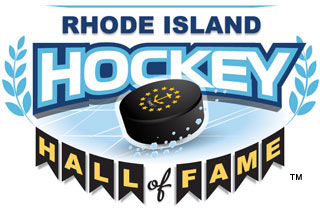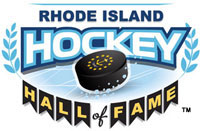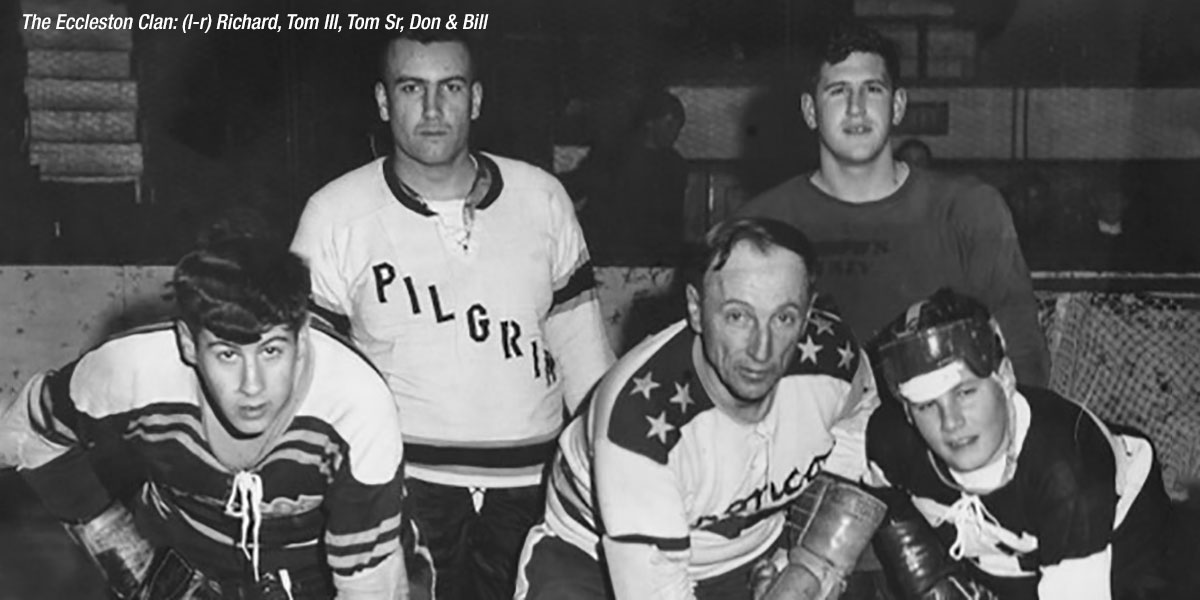The Eccleston family, while producing several high impact players at the high school and collegiate levels, have had the most influence in the world of hockey from behind the bench, beginning with legendary patriarch Thomas Eccleston, Jr.
Born in the north of England in 1910, Tom Jr. emigrated with his family to Bradford, RI, in 1912, where he played soccer with his English immigrant peers, the one sport he would letter in at Brown University. Passions for baseball, football, and basketball followed.
Tom got his first exposure to hockey in 1922 when the family moved to Lewiston, Maine, but when the family moved back to Rhode Island in 1926 and Tom took a post-grad year at the Moses Brown School, he failed to make the hockey team. However, the opening of the Rhode Island Auditorium that year had put local hockey enthusiasm into overdrive, and young Tom was caught up in it. Playing on the ponds at every opportunity, he became, by the time he was a senior at Brown University, a regular in the Intercity League, the amateur men’s circuit then thriving at the Auditorium. Oddly, though, it would be football that blazed the trail toward Tom’s hockey coaching career.
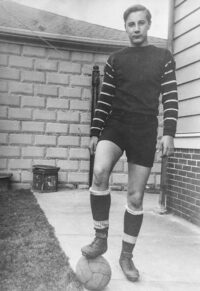 While Tom was playing varsity soccer for Brown on Saturdays, his competing interest was men’s amateur football, which he played surreptitiously on Sundays. The Great Depression was at its height and unemployed young men had nothing better to do than practice and play their favorite sports and earn a little pocket money in a day the when the local amateur games attracted paying fans. This was especially so for football. While a senior at Brown, Tom co-founded his own team, the Greenville Townies, and was the player-coach. They were winners right out of the gate, and when they went undefeated the next two seasons, the sports press dubbed the Townies the putative State Champions.
While Tom was playing varsity soccer for Brown on Saturdays, his competing interest was men’s amateur football, which he played surreptitiously on Sundays. The Great Depression was at its height and unemployed young men had nothing better to do than practice and play their favorite sports and earn a little pocket money in a day the when the local amateur games attracted paying fans. This was especially so for football. While a senior at Brown, Tom co-founded his own team, the Greenville Townies, and was the player-coach. They were winners right out of the gate, and when they went undefeated the next two seasons, the sports press dubbed the Townies the putative State Champions.
Despite all of the accolades that would come Tom’s way over the coming decades, it was his younger brother and only sibling, Don, who was considered the athlete in the family. Don was a 3-sport star and All-State hockey defenseman at Hope in 1933 before becoming team captain at Brown where he also starred on the baseball team. Like his older brother and a lot of other college athletes during the Depression, Don also “moonlighted” as a ringer in the men’s leagues. What better way to earn a buck or two when a buck was needed and it could buy a lot?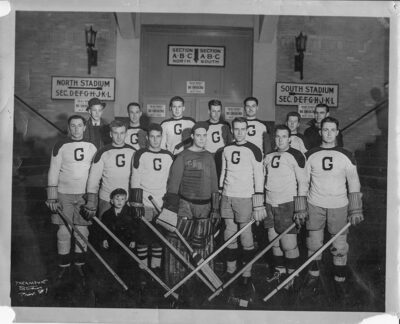
Meanwhile, Tom had graduated from Brown and began a teaching career at the Georgiaville Grammar School in Smithfield. When Burrillville, in 1934, decided to start a high school football team, Tom’s Townies record and the enthusiastic recommendation of his Smithfield Superintendent won him the job.
Starting the team from scratch, Tom’s boys won just one game that first season. But by the third they were runners-up, and by the fourth they were the champs. And over the next eighteen seasons they would capture ten more titles and seldom finish worse than runners up.
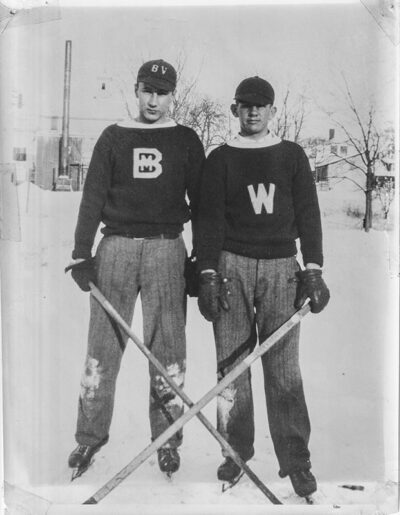 David vs Goliath being an irresistible fan draw, Tom’s Broncos were inevitably matched with the likes of LaSalle, Cranston and East Providence in the annual Injury Fund round-robin games, and they did not disappoint the crowds of thousands at the Cranston and Pierce stadiums. So acclaimed was his success that in 1949, when URI’s coach resigned after a winless season, 39 of the team’s players signed a petition to the Athletic Council requesting that Tom be hired, and the offer was made. But Tom, who had just been appointed BHS principal, turned it down. He was also coach of hockey by this time.
David vs Goliath being an irresistible fan draw, Tom’s Broncos were inevitably matched with the likes of LaSalle, Cranston and East Providence in the annual Injury Fund round-robin games, and they did not disappoint the crowds of thousands at the Cranston and Pierce stadiums. So acclaimed was his success that in 1949, when URI’s coach resigned after a winless season, 39 of the team’s players signed a petition to the Athletic Council requesting that Tom be hired, and the offer was made. But Tom, who had just been appointed BHS principal, turned it down. He was also coach of hockey by this time.
In the winter of 1938, mainly to provide himself practice time for his Intercity League ambitions, Tom founded an informal afternoon hockey club at BHS. He and the boys scrimmaged every day on a nearby millpond, and eventually Tom set up one real game with the Pomfret School, in nearby Connecticut, coached by old Brown friend, Wes Moulton, an All-American who would lead Brown to the NCAA championship game in 1951. Though outdoors and on pond ice, this was the first time the club played in a real rink and with goalie cages, boards, blue and red lines, and a referee. They lost, but no big deal.
Tom’s club continued on this informal basis until 1940, when after beating Pomfret for the first time, and then Hope High, the BHS principal, unbeknownst to Tom, signed up the team for the next season’s Interscholastic League. Tom reluctantly agreed to coach, predicting the team would lose every game…and they did, except for one tie. In season two, however, Mount St. Charles would win the State Championship only after Burrillville forced overtime in game three of the title series. Tom’s boys, now dubbed “the Broncos” by a Providence Journal reporter for their hustling style of play, would reach the State finals ten more times over the next fourteen seasons, winning six titles and thrice reaching the New England Tournament final.
Tom was one of the early American innovators of the game at a time when the Canadian product was mired in a hidebound orthodoxy, perhaps constrained by the limited horizons of its tiny, six-team professional league, and obscured by the superior skating and skills of its players.
Applying a football coach’s eye for situational play, Tom pioneered a variety of offensive and defensive positional systems and playsets, some of them audibled by the puck carrier as the situation called for—this in an era when hockey was thought “too fluid” a game for such coach-directed tactics. His constant motion and precisely timed practices would be familiar to the most up-to-date coach of today.
So impressive was the Broncos passing and positional play in beating the Dartmouth freshmen in 1949, that Eddie Jeremiah, the Green’s varsity coach and charter inductee of the U.S. Hockey Hall of Fame, wrote to the Providence Journal, “My freshman team just received a nice lesson on how the game of hockey should be played from the Burrillville High School hockey team. However, this letter is written primarily to pay tribute to their coach, Tom Eccleston Jr., and his players. In all my experience with schoolboy hockey, this team was the finest and smartest and best-coached team that I have ever seen.”
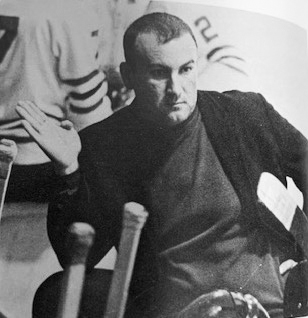 In 1956, in an arrangement allowing Tom to continue as BHS principal, Tom moved on to Providence College, where hockey had emerged from club status three years earlier. Promptly, his team recorded the young program’s best record. From there, season after season, the Friars gradually ascended the ladder of big-college Eastern hockey, led by such stars as Marshall Tschida, Lou Lamoriello, Bob Bellemore, and All-Americans Larry Kish and Grant Heffernan. The top rung was reached in 1964 when the Friars won the school’s first ECAC title—then the sole big-school league in the East—and made their first appearance in the NCAA final four Championship tournament. For this achievement, Tom’s peers in the AHCA awarded him the Spencer Penrose Trophy as the nation’s top collegiate hockey coach.
In 1956, in an arrangement allowing Tom to continue as BHS principal, Tom moved on to Providence College, where hockey had emerged from club status three years earlier. Promptly, his team recorded the young program’s best record. From there, season after season, the Friars gradually ascended the ladder of big-college Eastern hockey, led by such stars as Marshall Tschida, Lou Lamoriello, Bob Bellemore, and All-Americans Larry Kish and Grant Heffernan. The top rung was reached in 1964 when the Friars won the school’s first ECAC title—then the sole big-school league in the East—and made their first appearance in the NCAA final four Championship tournament. For this achievement, Tom’s peers in the AHCA awarded him the Spencer Penrose Trophy as the nation’s top collegiate hockey coach.
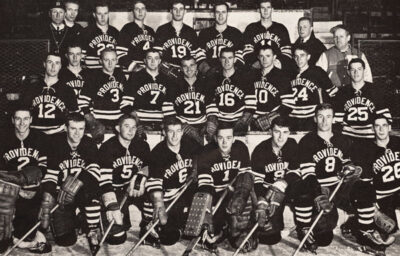 Tom’s elevation to the superintendency of the Burrillville schools, however, forced his retirement after this season. But when Tom retired from the job in 1971, he returned to coaching and teaching at the Hill School, a private boarding school in Pottstown, Pennsylvania.
Tom’s elevation to the superintendency of the Burrillville schools, however, forced his retirement after this season. But when Tom retired from the job in 1971, he returned to coaching and teaching at the Hill School, a private boarding school in Pottstown, Pennsylvania.
Employing his old playbook, adding exciting new tactics just recently displayed by the Soviet Union, and with his old New England hockey network providing much of the core talent, Tom quickly returned Hill to the top ranks of Northeastern prep hockey. Players from Burrillville, Barrington, Mt. St. Charles, and several Massachusetts schools took undergraduate or post-graduate years at the Hill. Top players included future Yale and NHL All-Star, Bob Kudelski; Providence College and AHL forward, Rene Boudreault; RPI and Detroit Red Wings defenseman, Tim Friday—who faced off against Boudreault and the in 1985 RPI vs PC NCAA championship game—and Bill Mandigo Jr., future three-time AHCA Women’s Div III Coach of the Year. Tom’s record in eleven seasons at Hill was 185-57-12. In 2007, the Hill School named its new rink after Tom, and later elected him to the school’s inaugural Athletic Hall of Fame class.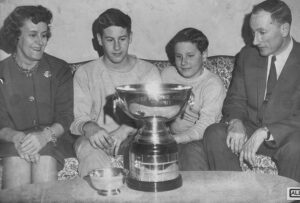
The Burrillville Broncos, meanwhile, had fallen on hard times since their last appearance in the RI State finals in 1976. Retiring home to Burrillville after Hill, Tom spent two quiet winters coaching the Junior High team. When the varsity coach resigned before the 1985-86 season, Tom, at age 74, again took up the Broncos reins and won a thrilling, three-game overtime victory over Ross Brooks’ Lincoln Lions for the Suburban Division Championship. Barrington would spoil the party at the next season’s title series, but Tom’s Broncos would win the next three Suburban championships before his final retirement in 1990. That year, the American Hockey Coaches Association awarded Tom his second honor from that body, the “Snooks Kelley Founders Award” for lifetime contributions to the game.
Tom considered himself a “coach,” period. It would be remiss not to mention that in nine seasons as BHS baseball coach, and in addition to 6 consecutive league titles, his three consecutive state championships established a record that stood for fifty years and was tied only twice. During the 1948 and ’49 school years, his football teams were undefeated league champs, and his hockey teams and baseball teams were also State champs—a remarkable combined record against Rhode Island high school opposition of 86-4. Many of his athletes were inspired by his example to choose careers in education and coaching, such as George Menard, Lou Lamoriello, Babe Mousseau, and Bill Mandigo Jr. Two of his sons and two of his grandsons would follow the same path.
Tom had four sons – Tom III, Don, Richard and Bill. As one might expect, Richard and Bill were well-rounded athletes and had some success skating with the Broncos for Tom’s protégé and successor, Babe Mousseau, and later in college. But compared to their older brothers, each modestly considered themselves journeymen left-wingers. Their older brothers were a cut or two above.
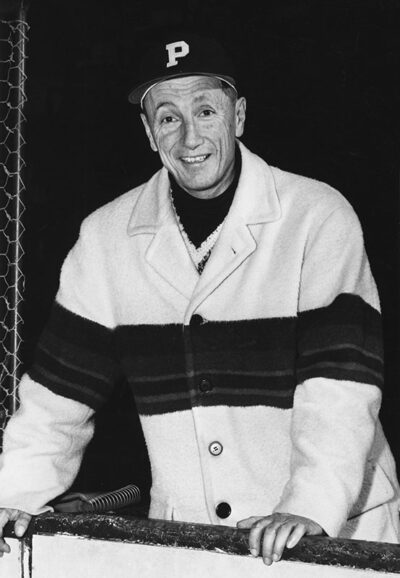 Tom’s eldest, Tom Eccleston III, was born in 1940, and grew up a three-sport athlete along the sidelines, behind the players’ bench, and along the base paths of his father’s career at Burrillville High. A three letterman at BHS, he quarterbacked the Broncos to a Class C title his senior season. In hockey, at defense, under Babe Mousseau, young Tom backstopped two consecutive State Champion teams, one a New England runner up, winning first team All-State and All-New England honors his senior season.
Tom’s eldest, Tom Eccleston III, was born in 1940, and grew up a three-sport athlete along the sidelines, behind the players’ bench, and along the base paths of his father’s career at Burrillville High. A three letterman at BHS, he quarterbacked the Broncos to a Class C title his senior season. In hockey, at defense, under Babe Mousseau, young Tom backstopped two consecutive State Champion teams, one a New England runner up, winning first team All-State and All-New England honors his senior season.
At Bowdoin College young Tom started at defense for the first three seasons under Hall of Fame coach, Sid Watson. After graduation in 1962, he embarked on a career that would match his father’s in breadth and go a fair distance matching it in accomplishment—if trophies were the only measure of a teacher-coach’s success. Tom III would coach football, hockey, and baseball, and serve as an athletic director, in one combination or another, for forty-three years at the high school, prep school, and even collegiate levels as a head coach or assistant. He began at Pilgrim High School in 1963 as the school’s first hockey coach, and as an assistant and later head coach of football, and assistant coach of baseball.
Tom had a tall order playing in the state’s top division for his first eight seasons while competing for talent with the city of Warwick’s other school, Warwick Veterans, and the Catholic schools. The Patriots nevertheless annually contended for state playoff seedings and produced some notable players such as Al Fairbanks, who played a season of Junior hockey in Canada under coach Scotty Bowman; goalie Pat Finch, who was a captain at Merrimack; and Eddie Good, small college All-American at Bowdoin and long-time coach and later Headmaster at the Northwood School, a career that influenced dozens of major hockey players.
Moving to the Suburban Division in 1971, Tom’s boys now contended for the title, and won it in 1975, his last season behind the hockey bench. Head coach of Pilgrim football the previous autumn, his Patriots had won the Class A Superbowl, the school’s first football title, a nice complement to the undefeated Class C title Tom had won at Burrillville in 1971 in his single season coaching away from Pilgrim and his first as a football head coach.
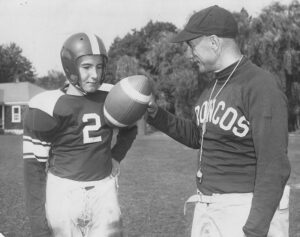 Tom continued as football coach at Pilgrim and assistant baseball coach until 1983, spending the “82 hockey season as Herb Hammond’s assistant at Brown. Then, in an unusual opportunity, he succeeded his retiring father, Tom Jr., as head hockey coach at the Hill School in 1983. A year later, a triple Hill-Burrillville connection was executed when Bill Mandigo Jr., a BHS and Wesleyan graduate who had PG-ed at Hill for Tom’s dad, came back to Hill as the younger Tom’s assistant coach. And when Tom, three seasons later, was elevated to Hill head football coach, Mandigo took Tom’s place as head hockey coach while Tom took Mandigo’s as his assistant. From Hill, Mandigo would move on to fame at Middlebury College.
Tom continued as football coach at Pilgrim and assistant baseball coach until 1983, spending the “82 hockey season as Herb Hammond’s assistant at Brown. Then, in an unusual opportunity, he succeeded his retiring father, Tom Jr., as head hockey coach at the Hill School in 1983. A year later, a triple Hill-Burrillville connection was executed when Bill Mandigo Jr., a BHS and Wesleyan graduate who had PG-ed at Hill for Tom’s dad, came back to Hill as the younger Tom’s assistant coach. And when Tom, three seasons later, was elevated to Hill head football coach, Mandigo took Tom’s place as head hockey coach while Tom took Mandigo’s as his assistant. From Hill, Mandigo would move on to fame at Middlebury College.
In a further, Burrillville-Hill-Bowdoin College connection, Kevin Potter, a defenseman, one of Tom’s PG’s from Burrillville, went next to Bowdoin and was named an AHCA first team College Division All-American in 1989. Potter then embarked on a distinguished coaching career at North Yarmouth and Lawrence Academies and is the present AD at the latter.
Tom left Hill for the Holderness School in New Hampshire in 1993 and again became a head hockey coach. His Holderness teams made the New England prep small school division playoffs each season. One of his most notable players was his son, Greg, a defenseman who was named a first team New England prep All-Star his senior year and played his college hockey at Union, subsequently making his career in the athletic shoe industry. But the itch to coach football struck once again, and after nine seasons at Holderness, Greg’s dad moved downstate to Proctor Academy to resurrect a long failing program. He spent eight years doing so, as well as coaching baseball and serving three years as athletic director.
Tom’s brother Donald, named for his Hope High All-State defenseman uncle, arrived in 1943 and lived up to the name. He played youth hockey for Burrillville at the Worcester Arena, and for Pete Davis’ East Side Bantams at Seekonk’s Iceland rink. A prodigy, he set a new team scoring record for freshmen while centering the second line for Burrillville’s 1958 State Champions and New England Tournament runners-up. Switched to defense the next season, Don made second team All-State as the Broncos again won the State title and finally reached the New England Championship summit.
The following season, as a junior, Don played a utility role on a thin but talented squad, seldom leaving the ice while switching between center and defense as the team won the league, finished runner-up to Hope in the state championships, and then beat Hope for the Broncos second New England title. Don was named All-State first team at defense and the MVP defenseman of the New England Tournament. Coach Babe Mousseau later called him “The smartest hockey player I ever coached.” Don was also selected first team All-Class at linebacker for his play on two consecutive undefeated Bronco football teams and was the first baseman for the Broncos Northern Division champions his junior year.
To prepare for an Ivy League college, Don moved to Deerfield Academy for his senior year, then was among a highly talented class recruited to Brown University by Jim Fullerton, where the outlook for Bears hockey was exceptionally bright with the opening that year of Meehan Auditorium. When his freshman season ended, Don played for the Rhode Island Scarlets in the National Junior Amateur Hockey Tournament and was named the MVP defenseman.
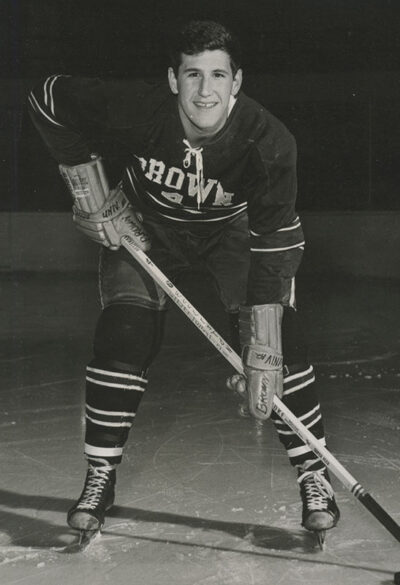 At Brown, Don played principally at defense, but also excelled in his old utility role in the face-off circle in special team’s situations, often taking double shifts. And so uncanny was his shot-blocking skill that he was equipped with a chest protector and functioned at times virtually as a second goaltender. In Don’s senior season, the Bears were Ivy League champs, ECAC runners-up, and made the Final Four NCAA tournament for the first time since 1951. Don was an Assistant Captain and named second team All-Ivy at defense. He won the University’s Class of 1907 Award for being the top student-athlete of his class. In 1994 he was elected to the Brown Athletic Hall of Fame, an honor conferred on his father in 1976.
At Brown, Don played principally at defense, but also excelled in his old utility role in the face-off circle in special team’s situations, often taking double shifts. And so uncanny was his shot-blocking skill that he was equipped with a chest protector and functioned at times virtually as a second goaltender. In Don’s senior season, the Bears were Ivy League champs, ECAC runners-up, and made the Final Four NCAA tournament for the first time since 1951. Don was an Assistant Captain and named second team All-Ivy at defense. He won the University’s Class of 1907 Award for being the top student-athlete of his class. In 1994 he was elected to the Brown Athletic Hall of Fame, an honor conferred on his father in 1976.
After grad school, a job in Governor Chafee’s office, and service in Viet Nam, Don followed brother Tom and his father into a teaching-and-coaching career, first as an assistant at Framingham South High School in 1973, and then as head coach at neighboring Holliston High in 1975 where he led the Panthers to the Tri-Valley League Championship in 1978.
The following season Don took the reins at Montclair High School in New Jersey, a state where hockey’s historically small footprint had exploded during that decade. However, while the disciplined game of Don’s New England high school and collegiate background was aspired to in New Jersey, it was often not practiced. The melee and mayhem of the professional game, as broadcast from New York and Philadelphia, was more the norm at both the youth and high school levels. Nonetheless, Don persevered. His first team notched Montclair’s first winning record in four seasons and qualified the team for the state tournament. By his third season, Don had shaped the Mounties into State Champions, and returned them to the title game in 1982. For this role as hockey evangelist, Don was elected to the New Jersey High School Hockey Hall of Fame in 2018.
Don’s hockey journey then folded back on his father’s, in a sense, when, the following year he was appointed history teacher and head hockey coach at the Pomfret School in CT, where the peep-frogs still sang in the marshy remains of the rink where it all began for his dad and the Burrillville Broncos. Prep hockey by the ’80’s had become a major destination for talent, and though Pomfret was and remains a small school, many of Don’s players moved on to collegiate careers. He was appointed Dean of Students in 1990, but, tragically, he died of a heart attack at the beginning of the 1993 school year. His team having brother Tom’s Holderness squad on its regular schedule, Pomfret instituted the Don Eccleston Trophy for the winner of the annual Pomfret-Holderness game.
Among the third generation of Ecclestons, it has been Tom III’s sons, Tommy and Rick, who have continued the family legacy. Tommy’s career, in particular, has had an extraordinary intersection with hockey coaching greatness.
As a freshman at Pilgrim High in 1982, playing for the legendary Mike Gaffney, Tom was part of a three-goalie rotation that had the unenviable job of replacing future NHL, PC and RI Hockey Hall of Famer, Chris Terreri. Moving to the Hill School the next season, Tom was a three-year starter, first for his dad, then two seasons for Bill Mandigo Jr. Then, following his dad to Bowdoin, Tommy played three seasons for two-time Div III AHCA Coach of the Year, Terry Meagher, whose record with the Polar Bears now exceeds Sid Watson’s. With a background like that, it was no wonder that Tommy sought a career in coaching.
He began at The Rectory School in Pomfret CT, hired by Headmaster Tom Army Jr.—yes, Tom Army Jr. of that legendary family. On the rink, Tommy was assistant to former East Providence and Colby College standout, Mick Ferrucci. Wilbraham and Monson Academy was the next stop where he assisted for two seasons, then as head coach led the team to its best record in recent memory in his first season. Which, in turn, propelled him back to the Hill School as head coach.
In eight seasons Tommy’s Hill teams compiled a 102-96-16 record and had 44 players move on to the Division I or III levels in college, several of whom were drafted, including Pat Rissmiller and Chris Bala who have had careers in the NHL. And among former players now in the coaching ranks is Matt Greason, whose Trinity College teams have compiled one of the best Div III records this century. Tommy, however, as he moved up the ladder in the Hill admissions department, had to give up his coaching duties. He is presently Assistant Headmaster for Enrollment Management. His two daughters, Tatum and Tanner, are collegiate lacrosse players at Kenyon and Trinity respectively, and one or both may well carry on the family coaching tradition.
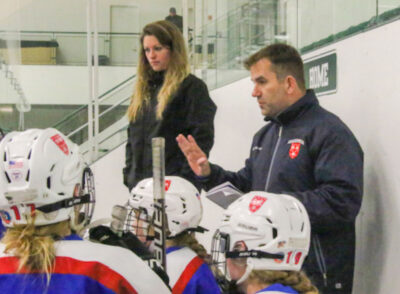 Rick, the youngest of Tom III’s boys, has followed a similar trajectory. After first lessons in hockey in the Warwick PAL and Edgewood organizations, he moved to Hill with the family and then to Holderness where he played for his dad at defense while also playing football and baseball. After earning his BA at Hobart College, he made stops at the New Canaan Country School and the Trinity Pawling School as a math teacher and assistant hockey and football coach, and assistant AD.
Rick, the youngest of Tom III’s boys, has followed a similar trajectory. After first lessons in hockey in the Warwick PAL and Edgewood organizations, he moved to Hill with the family and then to Holderness where he played for his dad at defense while also playing football and baseball. After earning his BA at Hobart College, he made stops at the New Canaan Country School and the Trinity Pawling School as a math teacher and assistant hockey and football coach, and assistant AD.
Rick landed his first head hockey position at the Kingswood Oxford School. Three years later, 2006, Rick returned to Holderness where he has been a math teacher, AD for ten years, head coach football, assistant coach of boy’s hockey, head coach girl’s hockey, golf coach, and JV baseball coach.
The highlight season of Rick’s football career, he declares, is 2013, when, after his defensive coordinator took a sabbatical, his dad, Tom, came out of retirement to take the post. The team went 6 – 2, Rick’s best record so far. Daughter Claire, now a high school freshman, plays wing for the New England Wildcats hockey team, which made it to the Tier II U-14 Nationals this past winter. Son Michael, a 7th grader, plays defense for the New Hampshire Avalanche and looks a lot like his great uncle Don at the same age; First grader, Hazel, will begin Mite hockey this winter.
Hockey, it seems, runs deep in the Eccleston DNA.
By Bill Eccleston
